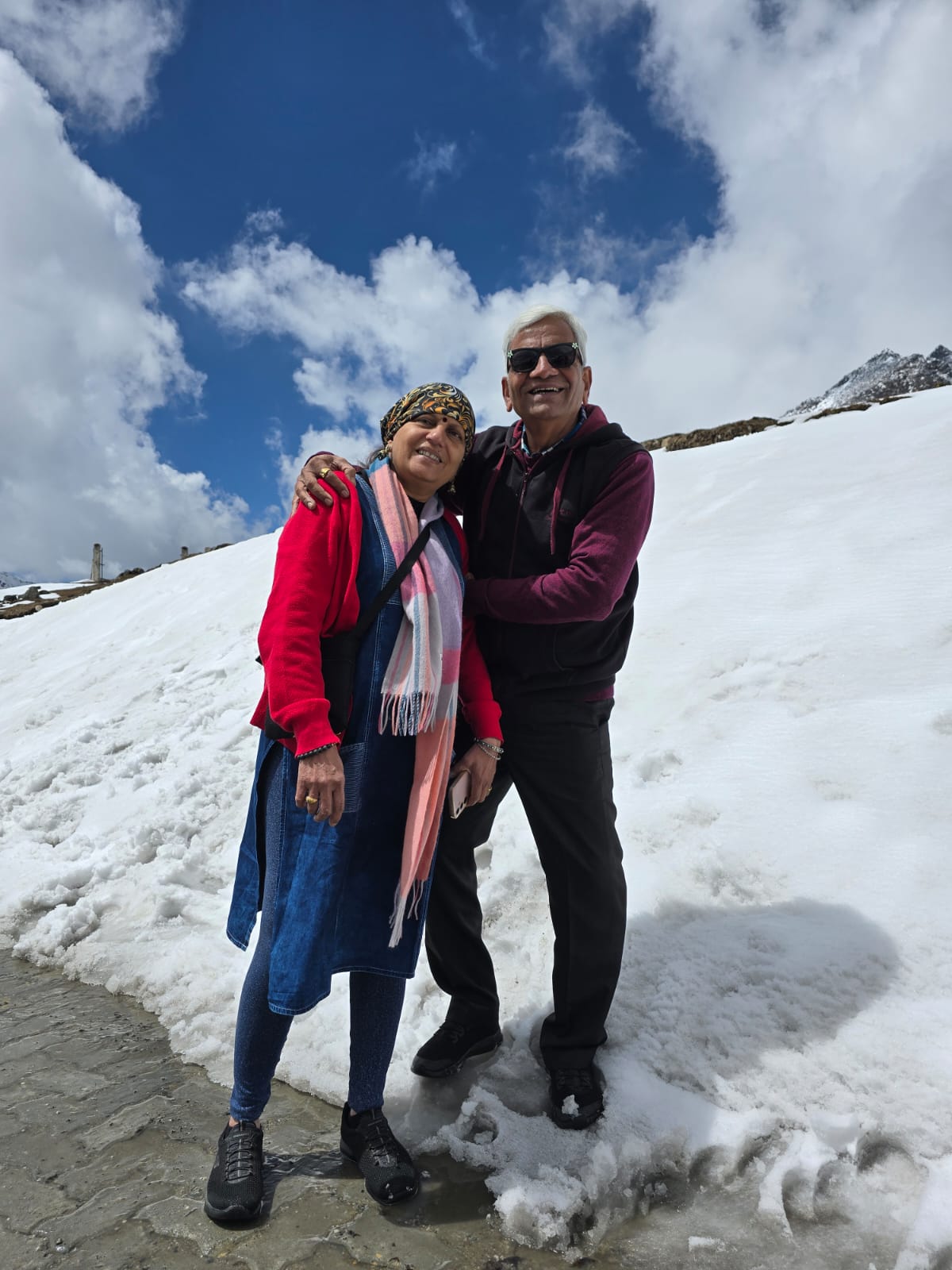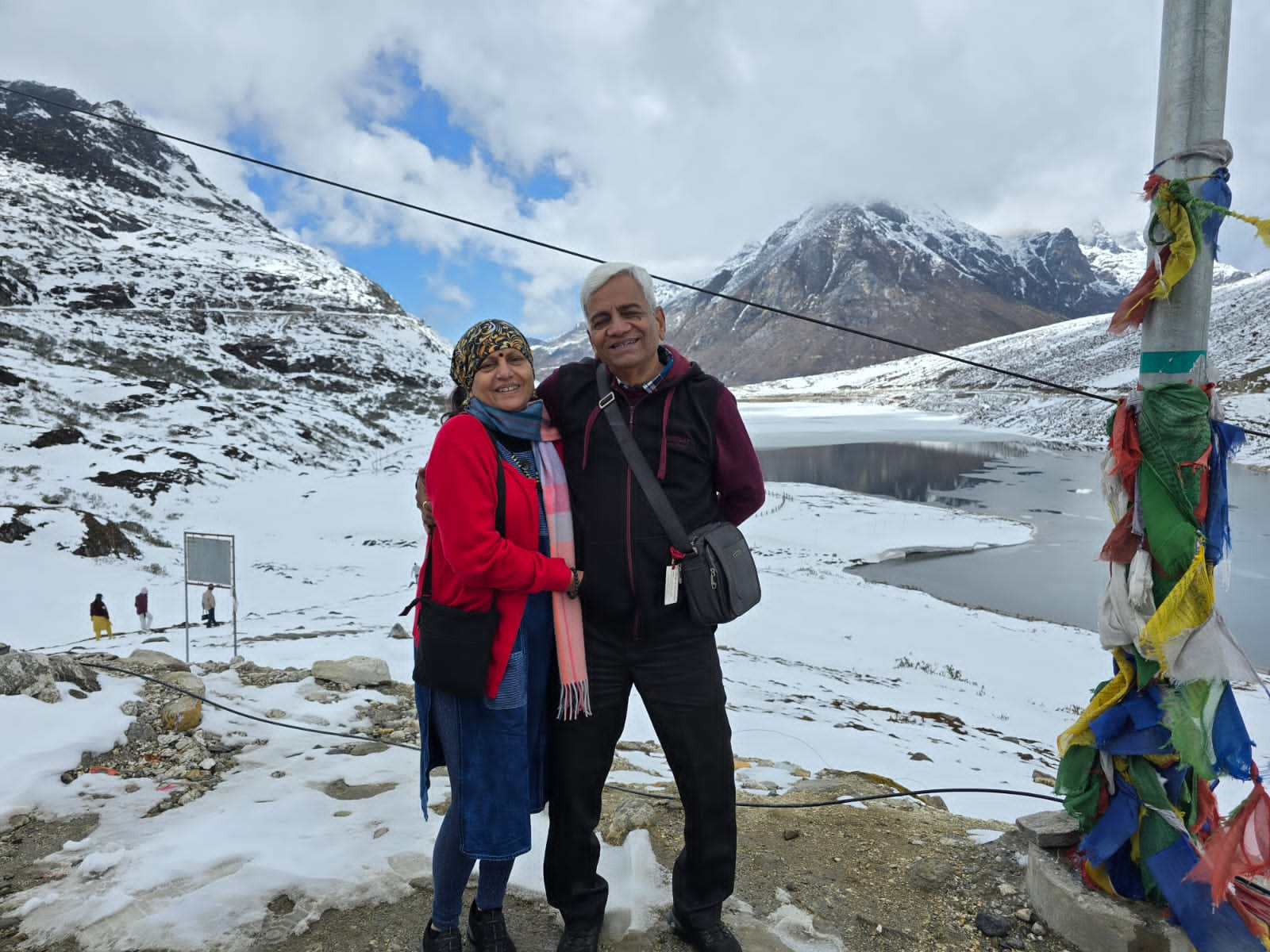BEJEWELLED NORTH EAST INDIA - A BREATH OF FRESH AIR !!!
The first destination was Umiam or Barapani lake, in Shillong, Meghalaya. The lake, a major tourist attraction, is created by building a dam on river Umiam, Waters were very calm and quiet. It offers a variety of water sports and we enjoyed boating. The sun setting in the backdrop, created a spectacular sight, hinting at much more of what we would enjoy in the coming days.
The next day, we visited the live root bridges at Mawlynnong, Dawki, a visual delight! These bridges are created by the local tribal, by intertwining rubber tree roots, across the strems, to connect villages with the forests Local villagers are more confident about the efficiency and convenience of these bridges rather than regular wooden bridges which give way in heavy rainfalls. Villagers easily travel across to the forests to collect wood, vegetables, fruits or for hunting.


It has been designated as the Asia's cleanest village cleanest village situated in Khasi Hills in Meghalaya. Mawlynnong is known for its cleanliness. The waste is collected in the bamboo dustbins, poured in pits and transformed into manure compost. All residents participate in village cleaning. Use of plastics and smoking is banned. Rain water harvesting and many such environment protection practices are encouraged. We walked through the village, witnessing truly, whatever we had heard!
Umngot or Dawki river boating
Cleanest river in Asia, known for very crystal clear waters, we can witness. River flows through Dawki, situated near India and Bangladesh border, Meghalaya. Water in the river gives boats an illusion of floating boats as waters are very clean and pollution less. This was our first glimpse of India - Bangladesh border.
Shillong peak
Shillong is a hill station, the capital of Meghalaya. It is the Khasi Hills district headquarter. Shillong is called as the "Scotland of the East" because of the beautiful surrounding hills. It is located two valleys of Brahmputra and Surma and has a cool climate. Shillong peak is a view point which lends local tribal dresses to flaunt and photograph in, offering life long memories.
Elephant falls
It is a picturesque falls like a natural unfolding symphony. It is situated near Shillong's central region, named after an elephant-shaped rock formation at its base. It is in the form of a two-tiered cascade, carving into mountains, running down through fern-covered rocks, melodiously gurgling its way down.
Situated on the edge of the Himalayas, it is in the midst of clouds.
Terraced green fields lie on every steep slope. Umpteen number of waterfalls rush down, to the valleys. Also known as Sohra, Cherrapunjee wears rains. It is one of the wettest places on Earth, attracting tourists from all over the world.
Ramakrishna Mission Anthropological Museum, Cherrapunji
It houses a good description of Northeast India and its population. It showcases the culture of all seven sister states. It has a tribal culture showcasing museum in a pleasant atmosphere. The museum displays handicrafts made by local Khasi tribes and artifacts.
Nohkalikai Falls
It is the tallest waterfall, 1,115 ft high near Cherapunji in Meghalaya. Water in Nohkalikai Falls comes from rainwater collected on the peak of a small plateau which weakens in summer. Falls jump in a very unusually shaded green pool.
Seven sisters falls
Situated in Meghalaya, also known as Nohsngithiang Falls, located in the Eastern region of Khasi Hills. These are seven parallel streams rushing down a 1,000 foot cliff, creating a beautiful, must visit site for nature lovers.
Mahamrutyunjay
Shiva Madir, Nagaon
It is a
majestically beautiful Shiva mandir situated at Nagaon, yet under construction.
It was opened to public in 2021. It has a 126 feet tall spectacular Shivlinga.
Tippi Orchids Research Centre, River View Point
It is located at Tippi in West Kameng
District of Arunachal Pradesh, about 65 km away from Tezpur (Assam) towards
Bomdila (the district headquarter of West Kameng). It is situated on the west
bank of Kameng river surrounded by high hills covered with semi evergreen
tropical rain forest vegetation. It stretches over an area of 10 hectares of
flat land comprising of office buildings, orchid farm, tissue culture lab, Museum,
herbarium and garden.
One of the main attractions of the centre is the orchid glass house, made up of
fiberglass roof, display gallery and a central pond with fountain, with about
1000 exotic orchids displayed in pots and hanging baskets. River view point is
at the backdrop.



The roads were all through ghats, lined by mountains and valleys. We were now entering Arunachal
Pradesh, via Tejpur. Dirang was our first halt, where we stayed the night. Weather had changed.
Temperature was chilling 2 degrees. All woollens had come out.
Dirang
Monastery or Dirang Dzong or Thupsung Dhargyeling Monastery, in the
West Kameng district of Arunachal Pradesh, India, is an important place of
Mahayana Buddhist learning. On the banks of Dirang river, surrounded by
mesmerizing landscapes, it is a tranquil
and spiritual place. With beautiful architecture, influenced by Tibetan culture,
it is brightly painted and intricately
designed in wood. Colourful and deeply symbolic Buddhist iconographies,
thangkas, and murals adorn interiors. It is a place for worship and meditation,
offering education and various social services to the locals. It is a centre of
cultural heritage in that region.
It is Located near Tawang, in Arunachal Pradesh, built in the honour of Rifleman Jaswant Singh Rawat, Hero of Indo-China war in 1962. It houses the statue Jaswant Singh Rawat, a museum, and is a memorial to the martyrs. It is located at 10,000 ft height.
The highlight of the trip was now to appear! We entered Baisakhi, 11,800 feet, where air was pure and crisp. Himalayas at their BEST!
We saw the Sela Warriors Memorial, dedicated to all martyrs in the war, protecting motherland.
We entered the Sela tunnel, all covered in snow. It is the connecting tunnel and I felt very proud as an Indian, to see the motorable roads in the 'very highly impossible to access' regions.
Sela pass
The Se La is a high - altitude pass in the mountains of Arunachal Pradesh, located on the border between the Tawang and West Kameng districts. It is 13,700 feet high, connecting Budhhist towns, Tawang to Dirang and Guwahati. It connects Tawang with Rest of India. It has scarce amounts of vegetation and is usually snow-covered throughout the year. Sela Lake, near the top of the pass, is one of sacred lakes. It is open throughout the year but is prone to landslides. Sela pass is one of the highest motorable mountain passes in the world.
Sela lake was a fantastic frozen glacier, a visual delight for tourists. We could play in the snow and enjoy the environment till satisfation. Weather had gone colder.
Tsangyang Gyatso, sixth Dalai Lama was the only Indian Dalai Lama. He was born on 1 March 1683 in Arunachal Pradesh. He was born in "Monyul" at a monastery near Tawang and was a Monpa by birth.
Tawang
Monastery is a Buddhist monastery located in tawang, in Arunachal Pradesh. It is the largest monastery in the country and the
second largest monastery in the world. It is situated in the Tawang valley,
close to Chinese and Bhutanese border.
It was
founded by Merak Lama Lodre Gyatso in 1680–168. It is three stories
high, enclosed by a 925 feet long compound wall, housing 65 residential
buildings. It has a library with valuable old scriptures.
We also visited Kameng War Memorial, dedicated to the unsung warriors of 1962 Indo-China war.
Gompa Monastery
A Gompa or Ling, is a sacred Buddhist spiritual compound where teachings and Sadhanas take place. It is like a University campus with living quarters. It is a meditation room, with a central shrine hall, Buddha statues, wall paintings. Often a library is on a floor above, with additional shrine rooms above. The gompa, or ling, may have sacred buildings, multiple shrine rooms, terraces, gardens and stupas.
Sitting Buddha statue
Jang falls
Nuranang
Falls or Jang Falls or Bong Bong Falls are 100 m high waterfalls, located
2 km northeast of the town jang on the motorable Jang Falls Road in Tawang, Arunachal Pradesh. Jang Hydal Plant, near the falls base, is a
small hydro-electric plant which generates electricity
for local use.
The Nuranang river originates from the Northern slopes of Sela Pass. After the waterfall it merges with river Tawang. It is named after a local girl Noora. She helped Rifleman Jaswantsingh Rawat, the post humous winner of Maha Veer Chakra.
It si a place popular also because of Film “Koyala” shot here.
Bomdila Monastery
Bomdila Monastry is one of the most famous monasteries in Arunachal Pradesh, North East India, made in 1965. It houses Buddhist Lamas and monks and belongs to Mahayana Buddhism. It is a copy of Tsona Gontse monastery at Tsona in Tibet. A prayer hall was later added to the monastery, it houses an extremely beautiful Buddha temple.
Assam boasts of tea and petroleum, but is best known for an ample variety of orchids, which are beautiful, complex, colourful, showy and expensive flowers. They symbolize our national heritage.
The Kaziranga National Orchid and Biodiversity Park is located at the distance of 2 km from the Central Kaziranga. The park is spreads in an area of about 6 acres in the Durgapur village. It is as the largest orchid park in the Northeast India. The park has more than 500 varieties of wild orchids, 46 species of bamboo, 132 species of fruits and leafy vegetables, 12 species of cane, many types of cacti and variety of species of local fishes. The whole variety of orchids is preserved in a greenhouse, along with hybrid varieties; collected from local regions.
Kaziranga National Park
Kaziranga National Park has the highest population of one horned Rhinoceros. We toured the national park on elephant back as well as in safari jeeps. We witnessed elephants, large number of Rhinos, wild boars, Multi horned sambars, variety of deer, monkeys and birds. We just missed seeing
Umananda Devaloi is a beautiful temple of Shiva bhagwan, on Umananda or Peacock Island in the middle of Brahmaputra river, in Guwahati.
Brahmaputra river Cruise Alfresco grand
We enjoyed the cruise in Brahmaputra, for about three hours with cultural Bihu dance, singing and dining. It added to the beauty of Northeast.
The Kamakhya Temple situated in the Nilachal hills of Guwahati in Assam. It is one of the oldest worshipped temple of Shhri Kamakhya goddess. It was built in the 8th - 9th century in a hybrid architecture style. It is among 51 shakti pithas and one of the the oldest 4 of them. It was crowded with devotees who waited for hours to get a glimpse of the Goddess. We were lucky to visit and worship the goddess.
GREEN BLOGGER
PROF. DR. MRS. JAYA VIKAS KURHEKAR
KEYWORDS : FASCINATING ENVIRONMENT, NORTHEAST INDIA, LIVE ROOT BRIDGES, WATERFALLS, VALLEYS, WAR MEMORIALS, KAZIRANGA WILD LIFE, ORCHIDS.
















































































No comments:
Post a Comment